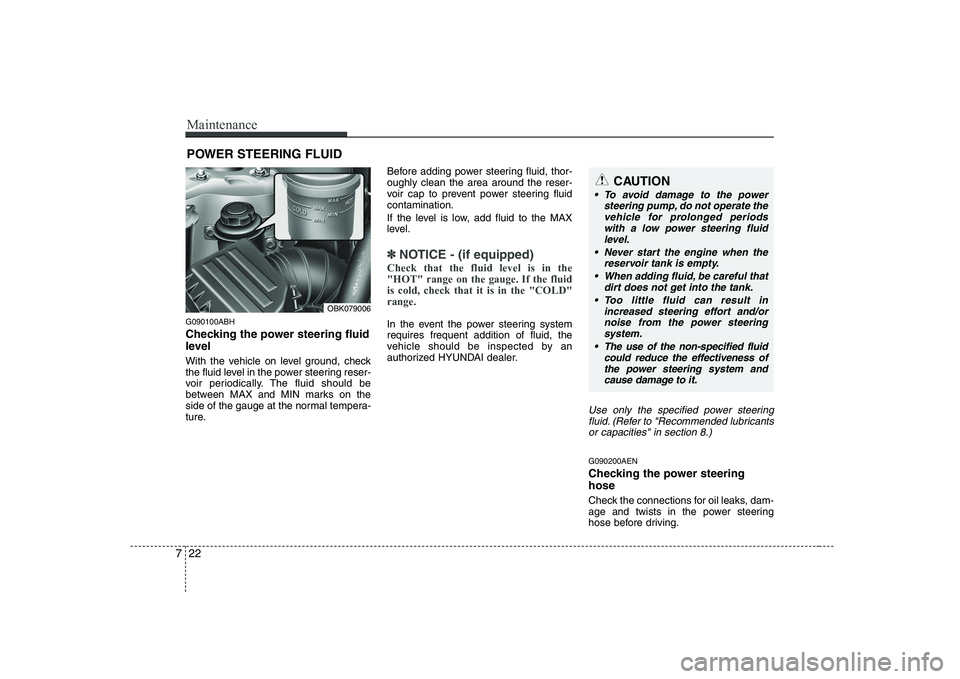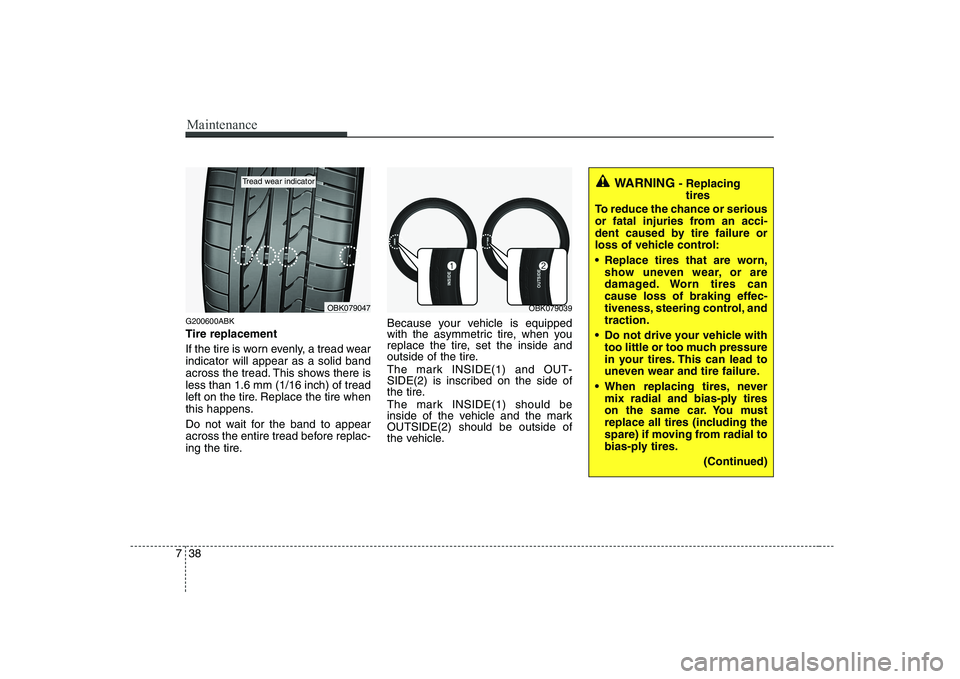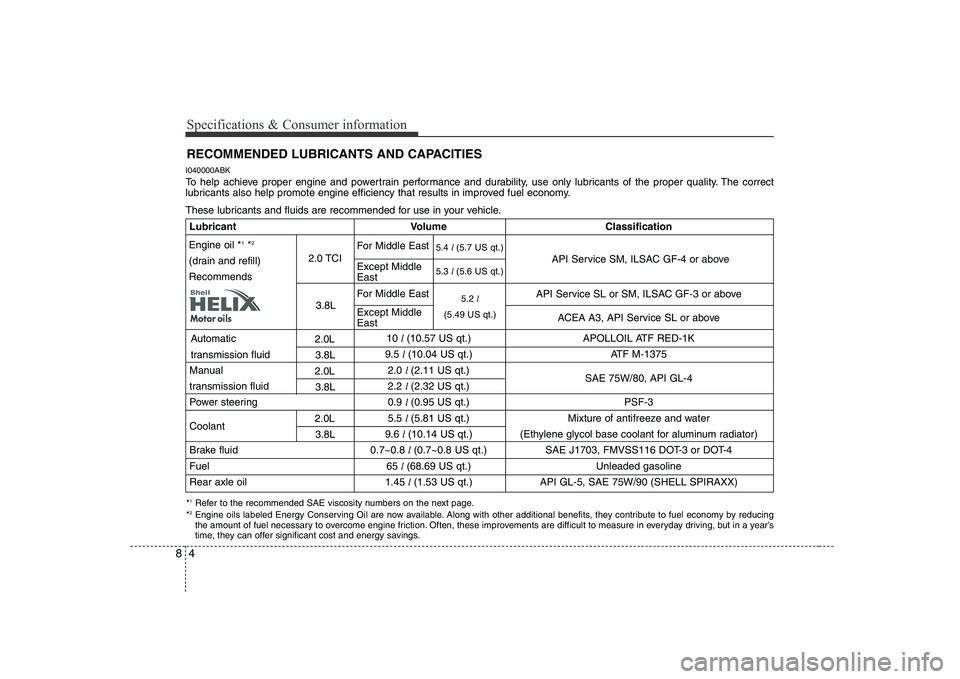Page 262 of 332

Maintenance
12
7
G040200ABK
MAINTENANCE UNDER SEVERE USAGE CONDITIONS
The following items must be serviced more frequently on cars mainly used under severe driving conditions.
Refer to the chart below for the appropriate maintenance intervals.
R : Replace I : Inspect and if necessary, adjust, correct, clean or replace
Engine oil and 2.0 TCI R Every 5,000 km (3,000 miles) or 3 months
A, B, C, D, E, F,
engine oil filter 3.8L For Middle East R Every 5,000 km (3,000 miles) or 6 months
G, H, I, K, L
Except Middle East R Every 7,500 km (4,500 miles) or 6 months
Air cleaner element R C, E
Spark plugs R B, H
Manual transmission fluid R Every 100,000 km (62,000 miles) C, D, E, G, H, I, K
Automatic 2.0 TCI For Europe R Every 45,000 km (30,000 miles)
A, C, D, E, F
transmission fluid Except Europe R Every 40,000 km (25,000 miles)
G, H, I
3.8L R Every 80,000 km (50,000 miles)
Steering gear rack, linkage and boots I C, D, E, F, G
Rear axle oil R Every 120,000 km (75,000 miles) C, E, G, H, I, K
MAINTENANCE ITEMMaintenance
operation Maintenance intervals
Driving condition
Replace more frequently
depending on the condition
Inspect more frequently
depending on the condition Replace more frequently
depending on the condition
Page 266 of 332

Maintenance
16
7
G051600AUN Brake fluid
Check brake fluid level in the brake fluid
reservoir. The level should be between
“MIN” and “MAX” marks on the side of
the reservoir. Use only hydraulic brake
fluid conforming to DOT 3 or DOT 4specification.
G051700AUN
Parking brake
Inspect the parking brake system includ-
ing the parking brake pedal and cables.
G051900AUN
Brake discs, pads, calipers and
rotors
Check the pads for excessive wear, discs
for run out and wear, and calipers for fluid
leakage.
G052100AUN Suspension mounting bolts
Check the suspension connections for
looseness or damage. Retighten to the
specified torque. G052200AUN
Steering gear box, linkage &
boots/lower arm ball joint
With the vehicle stopped and engine off,
check for excessive free-play in the
steering wheel.
Check the linkage for bends or damage.
Check the dust boots and ball joints for
deterioration, cracks, or damage.
Replace any damaged parts. G052300AEN
Power steering pump, belt and hoses
Check the power steering pump and
hoses for leakage and damage. Replace
any damaged or leaking parts immedi-
ately. Inspect the power steering belt (or
drive belt) for evidence of cuts, cracks,
excessive wear, oiliness and proper ten-
sion. Replace or adjust it if necessary.
G052400AUN Drive shafts and boots
Check the drive shafts, boots and clamps
for cracks, deterioration, or damage.
Replace any damaged parts and, if nec-
essary, repack the grease.
G052500AUN
Air conditioning refrigerant (if equipped)
Check the air conditioning lines and con-
nections for leakage and damage.
Page 272 of 332

Maintenance
22
7
POWER STEERING FLUID
G090100ABH
Checking the power steering fluid
level
With the vehicle on level ground, check
the fluid level in the power steering reser-
voir periodically. The fluid should be
between MAX and MIN marks on the
side of the gauge at the normal tempera-
ture. Before adding power steering fluid, thor-oughly clean the area around the reser-
voir cap to prevent power steering fluidcontamination.
If the level is low, add fluid to the MAX
level.
✽✽
NOTICE - (if equipped)
Check that the fluid level is in the "HOT" range on the gauge. If the fluidis cold, check that it is in the "COLD"range.
In the event the power steering system requires frequent addition of fluid, the
vehicle should be inspected by an
authorized HYUNDAI dealer.
Use only the specified power steering fluid. (Refer to "Recommended lubricantsor capacities" in section 8.)
G090200AEN
Checking the power steering hose
Check the connections for oil leaks, dam-
age and twists in the power steering
hose before driving.
CAUTION
To avoid damage to the power
steering pump, do not operate thevehicle for prolonged periods with a low power steering fluid
level.
Never start the engine when the reservoir tank is empty.
When adding fluid, be careful that dirt does not get into the tank.
Too little fluid can result in increased steering effort and/or
noise from the power steeringsystem.
The use of the non-specified fluid could reduce the effectiveness of
the power steering system and cause damage to it.
OBK079006
Page 288 of 332

Maintenance
38
7
G200600ABK Tire replacement
If the tire is worn evenly, a tread wear indicator will appear as a solid band
across the tread. This shows there isless than 1.6 mm (1/16 inch) of tread
left on the tire. Replace the tire when
this happens.
Do not wait for the band to appear
across the entire tread before replac-
ing the tire. Because your vehicle is equipped
with the asymmetric tire, when you
replace the tire, set the inside and
outside of the tire.
The mark INSIDE(1) and OUT-
SIDE(2) is inscribed on the side of
the tire.
The mark INSIDE(1) should be
inside of the vehicle and the markOUTSIDE(2) should be outside of
the vehicle.
OBK079047
Tread wear indicatorWARNING
- Replacing
tires
To reduce the chance or serious
or fatal injuries from an acci-
dent caused by tire failure or
loss of vehicle control:
Replace tires that are worn, show uneven wear, or are
damaged. Worn tires can
cause loss of braking effec-
tiveness, steering control, andtraction.
Do not drive your vehicle with too little or too much pressure
in your tires. This can lead to
uneven wear and tire failure.
When replacing tires, never mix radial and bias-ply tires
on the same car. You must
replace all tires (including the
spare) if moving from radial to
bias-ply tires.
(Continued)
OBK079039
Page 322 of 332

Specifications & Consumer information
4
8
RECOMMENDED LUBRICANTS AND CAPACITIES
I040000ABK
To help achieve proper engine and powertrain performance and durability, use only lubricants of the proper quality. The correct
lubricants also help promote engine efficiency that results in improved fuel economy.
These lubricants and fluids are recommended for use in your vehicle.
* 1
Refer to the recommended SAE viscosity numbers on the next page.
* 2
Engine oils labeled Energy Conserving Oil are now available. Along with other additional benefits, they contribute to fuel econo my by reducing
the amount of fuel necessary to overcome engine friction. Often, these improvements are difficult to measure in everyday driving, but in a year’s
time, they can offer significant cost and energy savings.
Lubricant Volume Classification
API Service SL or SM, ILSAC GF-3 or aboveACEA A3, API Service SL or above
10 l (10.57 US qt.) APOLLOIL ATF RED-1K
9.5 l (10.04 US qt.) ATF M-1375
Manual 2.0 l (2.11 US qt.)
SAE 75W/80, API GL-4
transmission fluid 2.2 l (2.32 US qt.)
Power steering 0.9 l (0.95 US qt.) PSF-3
Coolant 5.5
l (5.81 US qt.) Mixture of antifreeze and water
9.6 l (10.14 US qt.) (Ethylene glycol base coolant for aluminum radiator)
Brake fluid 0.7~0.8 l (0.7~0.8 US qt.) SAE J1703, FMVSS116 DOT-3 or DOT-4
Fuel 65 l (68.69 US qt.) Unleaded gasoline
Rear axle oil 1.45 l (1.53 US qt.) API GL-5, SAE 75W/90 (SHELL SPIRAXX)
Engine oil * 1
*2
(drain and refill) Recommends 2.0 TCI
3.8L
Automatic
transmission fluid
2.0L3.8L
2.0L
3.8L
2.0L
3.8L API Service SM, ILSAC GF-4 or above5.4
l (5.7 US qt.)
5.3 l (5.6 US qt.)
5.2 l
(5.49 US qt.)
Except Middle East
For Middle East
Except Middle East
For Middle East